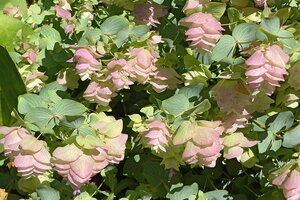Ornamental oregano is a delightful perennial plant
Perfect for rock gardens and regions with well-drained soil and winters on the dry side, ornamental oregano is an attractive flowering perennial that's easy to grow.

Kent Beauty is a very attractive variety of ornamental oregano. It has bushy, pale green and mauve bracts, which are long-lasting.
Courtesy of Jane Shellenberger
If you’re looking for an unusual, beautiful perennial that’s easy to grow, try an ornamental oregano or two.
After first noticing one many years ago in Tim and Laura Spear’s pollinator-friendly Forest Edge Gardens north of Colorado Springs, I now have five different cultivars in my garden. They never fail to attract visitors’ attention.
Ornamental beauty
Some ornamental oreganos have flowers similar to the culinary varieties, but my favorites have tiny pink or purple florets peeking out of prominent papery bracts that cascade over rocks in the garden and jiggle like chandeliers on branched stems in a vase.
Origanum libanoticum, the Lebanese or hopflower oregano [see second photo above; click on arrow at right base of first photo], has narrow, chartreuse, shrimplike bracts with small, protruding lavender flowers.
Always ahead of the curve, Panayoti Kelaidis (senior curator and director of outreach at the Denver Botanic Gardens) planted it more than 30 years ago at the entrance to the Rock Alpine Garden, where the original specimen still thrives.
Deep rosy-red ‘Pilgrim’ has an upright growth habit, striking against my starry, silvery blue eryngium. [See first photo at left.] Much of mine has sprawled out, maybe because it only gets five hours of full sun.
Lime-green Origanum acutidens is especially lovely tumbling over red sandstone boulders and hybrid ‘Amethyst Falls’ is another cascading type with loads of bright pink flowers poking out of chartreuse bracts. The lavender-rose bracts of Origanum X suendermannii are also very showy.
‘Kent Beauty’ was the first to be available in the trade. It has bushy, pale green and mauve bracts that are long-lasting in the garden and as a cut flower. [See first photo above for Kent Beauty in the garden and the second photo at left for it as a cut flower.] In fact, displayed in a vase it’s easier to see the beautiful whorled form and the silver veining in its leaves.
Most of the ornamental oreganos with flower bracts have blue-green foliage, and some are fragrant or aromatic.
They resemble the darker pink, fuzzy-leaved (now rare) wildflower, Dittany of Crete (Origanum dictanunus), famous for what are considered healing, aphrodisiac, and magical properties. Woe to any plant known as a sexual enhancer, but fortunately, this endangered and protected plant once known as “the gift of the gods” is now under cultivation mostly in Greece, the only place where it grows wild -- on hard-to-reach, rocky cliffs.
There is also some limited cultivation elsewhere, including in the United States. Dittany of Crete is hardy only to Zone 7, while the others mentioned here are all hardy to Zones 4 or 5.
How to grow
These oreganos like full sun and aren’t fussy about soil as long as isn’t too rich and it drains well. They prefer winters on the dry side, as we usually have in the West, and they like to dry out between waterings. Once established, they are drought-tolerant. Mine are not irrigated, and I don’t water them unless conditions are very dry.
While deer and rabbits avoid them, bees love all oreganos, those with flower bracts are favored by bumblebees. Other cultivars with flowers similar to Italian and Greek oreganos (the best culinary types, which have white flowers) are bee and butterfly magnets, including ‘Herrenhausen,’ hardy to -30°F., and the rosier, more floriferous, and compact ‘Rotkugel.’ These can also handle more water and wetter winters.
The common purple-flowered oregano, Origanum vulgare, brought to North America by European immigrants, is considered a highly medicinal plant. It’s also invasive and has naturalized in parts of the US and Mexico. The prettier ornamentals are much better behaved and will provide many years of delight in the garden.
-----
Jane Shellenberger lives on five acres at 5,000 feet on the plains in Hygiene, Colo., between Boulder and Longmont. She is the publisher and editor of Colorado Gardener, "a thinking gardener's companion." Her book, "Organic Gardener's Companion: Growing Vegetables in the West," will be available in spring 2012. To read more by Jane here at Diggin' It, click here.
